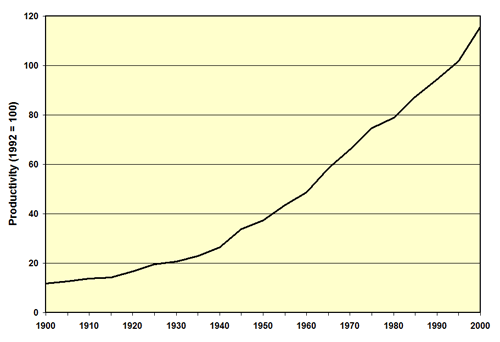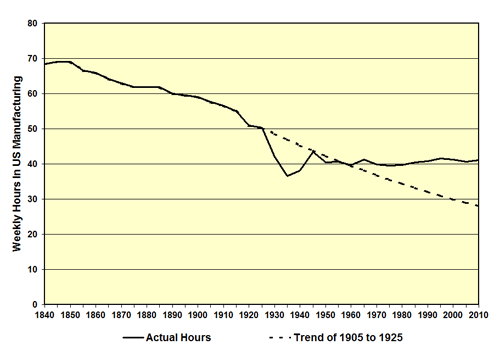
Work Time and Economics
Work Time Choice: Model Policies
Work Time and Economics
We can create jobs either by increasing output or by reducing the average work week. During most of American history, we did both. But since World War II, we have not reduced work hours.
When the Netherlands increased part-time work dramatically, it caused the "Dutch employment miracle," with unemployment falling from 13% in the mid-1980s to 6.7% in 1996, as employers hired new workers to fill in for those who shortened their hours.
We could have a similar "employment miracle" in the United States.
Productivity and Free Time
Ever since the beginning of the industrial revolution, improved technology has allowed workers to produce more per hour of work. During the twentieth century, American productivity grew rapidly, so the average American worker in 2000 produced almost 10 times as much in an hour as the average worker in 1900.
American Productivity (Output per Worker Hour)
source: Historical Statistics of the United States: Earliest Times to the PresentIncreasing productivity means that technology is constantly eliminating existing jobs, as machines do work that people used to do.
We can make up for these lost jobs by:
- Producing More: For example, if productivity increases 2% annually, we can produce 2% more every year.
- Working Less: For example, if productivity increases 2% annually, we can work about 2% less every year.
- A Combination of Both: For example, if productivity increases 2% annually, we can produce 1% more and work about 1% less each year.
During the nineteenth and early twentieth century, we did both. Higher productivity gave American workers both more income and shorter hours.
In the early nineteenth century, the typical American factory worker worked six days a week, twelve hours a day. Unions fought for shorter hours and for higher wages, and the average work week in manufacturing gradually declined until the 1930s, as we can see in this graph.
Average Work Week in US Manufacturing
source: Historical Statistics of the United States: Earliest Times to the PresentBut the Fair Labor Standards Act of 1938 set the standard work week at 40 hours. After World War II, in a reaction against the unemployment of the Great Depression, there was a massive effort to promote growth and provide more of those 40-hour jobs.
In a reversal of the historical trend, the work-week did not decline during the 1950s and 1960s, despite higher wages and widespread economic prosperity (as we can see in the graph above).
We provided more jobs purely by producing and consuming more. We stopped reducing work hours. Many decades later, despite the tremendous changes in our society and our economy, we still have the 40-hour jobs of 1938.
Our society is out of balance because we focus on increasing output and we ignore free time. Because other developed nations continued to increase both income and free time, the United States now has the longest work hours of any industrial nation, according to the OECD.
What Is An Economy For?
Macroeconomic planning would still be needed with work time choice, but the key difference is:
- Today, we must plan to stimulate economic growth rapid enough to provide everyone with standard 40-hour jobs.
- With work-time choice, we would plan to create growth rapid enough to give everyone the the number of work hours that they actually want.
Today, we must buy more products, whether we want them or not, purely to create more 40-hour jobs. With work-time choice, people would work enough to buy the products they want, and then they could stop.

Follow Us
The book behind the initiative


